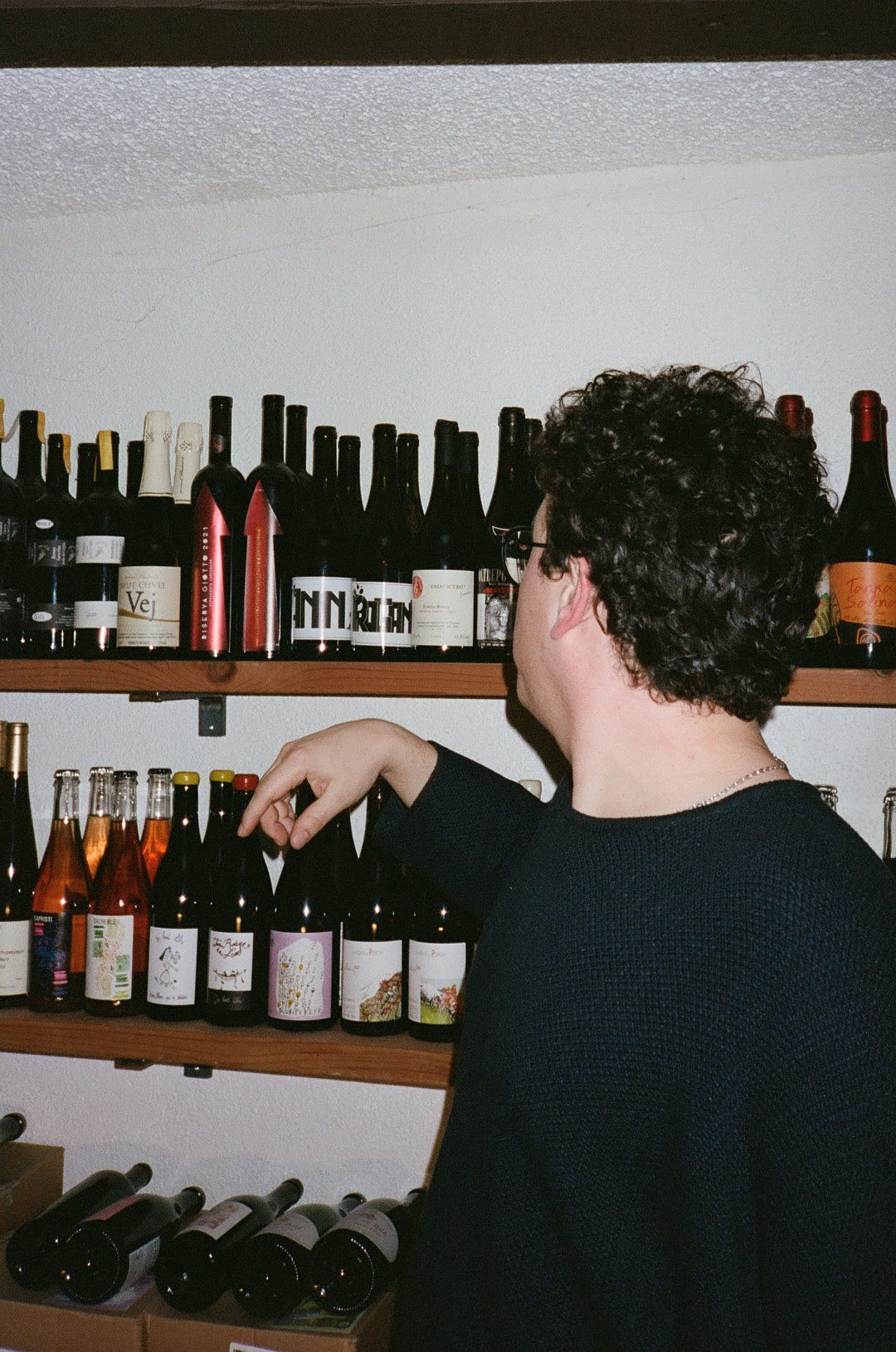Wine Person Brian Allen Simon is More of a Maestro Than a Merchant
With CANTA, he conducts L.A.’s most compelling wine shop.
Photographs by David Gurzhiev
In the hills above Silver Lake, just down the street from The Paramour Estate, there’s a secret wine shop that only real heads know. In the windowsill, a lineup of empty wine bottles depict the proprietor’s taste, just like in the natural wine bars of Paris and Tokyo. Upstairs, in a room shrouded from sunlight, hundreds of unopened bottles are neatly arranged across three wooden shelves. It’s not a bar nor a brick-and-mortar, but CANTA — a mostly online cellar that Brian Allen Simon runs out of his apartment.
CANTA’s customer base is comprised of less than 20 drinkers with custom monthly subscriptions, in addition to anyone who makes an appointment to swing by and shop a la carte. The clientele tends to be decently knowledgeable about wine; as a one-man operation, Simon can’t take care of everybody, but he can cater to those who are drawn to — and therefore trustworthy of — his taste. “Because I’m pretty specific with the winemakers that I sell and the importers that I work with, it’s very dialed in,” he says.
“CANTA” is a reference to a rosé, Canta Mañana, produced in the Roussillon region of France. The winemaker, Alain Castex, passed away last year. “It’s a pretty simple wine, but it really embodies a spirit and a place and a person,” says Simon. In that way, it’s representative of CANTA’s underlying ethos: to carry wines by producers “who have more of an artistic spirit towards making wine rather than just a commercial one.”
Simon, born and raised in Los Angeles, is not only a wine person, but also a saxophonist and experimental musician. He sees CANTA as one part of his artistic practice. Under his producer name ANENON, he released an album last fall called Moons Melt Milk Light, which he’ll be touring in Europe this spring. Formerly, Simon ran a record label called Non Projects, which he shut down in 2015, “coincidentally” the same year he started drinking natural wine. “It was kind of a slow burn,” he says about his call to wine. “It’s still hard to find information, but nine years ago, there really wasn’t much. I didn’t have this breakthrough moment, I sort of just kept going.” He says he was able to learn “what the good shit was” early on from following the natural wine scene in Japan, where the importers are the farthest ahead of the curve.
In 2018, Simon became friendly with the restaurateur David Wynn while a regular customer at his now-closed coffee shop, Triniti, in Echo Park. They bonded over music, then wine, and Wynn offered him a job overseeing the list at Kensho (also now-closed), the Japanese restaurant and wine bar he was opening in the Hollywood Hills. The opportunity was timely, as Simon had recently returned from a long wine-focused trip to France and Australia, and his interest was deepening. He accepted the gig, despite the fact that he had never worked in a restaurant before. “I feel like I got the job because this guy liked my music, more so than any other reason. Which is very L.A. to me,” Simon says.
The connective tissue between music and wine is a prevalent theme within CANTA. Simon says he finds it easy to connect with evasive winemakers whose vineyards he wants to visit because he shows up as a musician with a curiosity about wine, as opposed to as a wine professional. “So many winemakers are either hugely into music and art, or they’re musicians themselves, too,” he says.
“I feel like I got the job because this guy liked my music, more so than any other reason. Which is very L.A. to me.”
Kensho opened in 2019, and Simon worked at the restaurant throughout the first part of the pandemic, which is when he started CANTA, as a COVID-era club for drinkers stuck at home. As it’s evolved, writing has become central to the project, and another pillar of Simon’s artistic practice. He publishes descriptive, personal paragraphs about the wines he carries on CANTA’s website and on Substack (
), which center the people who made the wine, the place in which it was made, and in certain cases, the experience he had while visiting the vineyard. “I try to talk about the wine as little as possible,” Simon says. He’s less interested in communicating about tasting notes and tannin levels and more concerned with the human side of winemaking.For example: “I find it beautiful that most drinkers of Samuel Boulay’s wines have no idea what he looks like—zero corruption. When visiting Sam, phones and cameras are kindly asked to be directed at anywhere but him.” Also, “Bernard, a confidently quiet gentleman who has been farming since the early 80s, now works a mere hectare (compared to five when he first began), and now mostly focuses on baking bread that he sells at the local farmer’s market each week.”
It’s a style of storytelling that’s refreshingly sincere compared to the gatekeep-y jargon employed by most of the wine world. For a musician who fell into wine quite naturally, that’s how it should be: “There needs to be some sort of emotional connectivity to the wine, otherwise, it’s just a product.”
Page through Simon’s writing and you’ll start to get a sense of how he interacts with the wine world, and what he likes to drink. The best way to experience CANTA, however, is to stop by his Silver Lake shop (well, home) and hear his stories. It won’t be long before you’re uncorking something genuinely delicious.












This one was a delight to read!